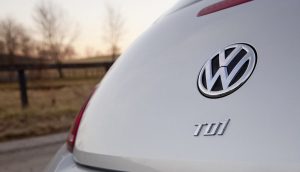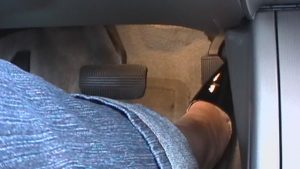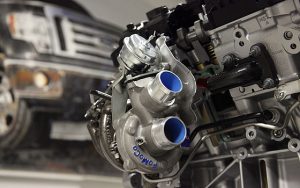Jaguar has decided – and just announced – it will no longer offer a diesel engine in the XE sedan. Which was one of the last passenger cars still available in the U.S. with a diesel engine – Mercedes, BMW and Audi having dropped their diesel offerings well ahead of Jaguar.
The reason why they dropped them – which none of them will state openly – is that diesels no longer make much of a case for themselves.
They cost too much – and their mileage advantage isn’t much anymore.
And one other thing, which we’ll get to presently.
All of the above attributable to Uncle – including the one thing he probably didn’t intend to happen.
On MPGs: The 2019 XE’s 2.0 liter turbodiesel four carries a rating of 30 city, 40 highway – which is pretty good. But the XE’s gas-turbo 2.0 liter engine also delivers pretty good mileage – 25 city, 34 highway.
It’s almost as good as the diesel’s mileage, in fact. The difference amounts to 5-6 MPG, in favor of the diesel.
It isn’t much of a spread.
It is even less of a spread when you take into account the cost of diesel fuel – which is currently averaging about 20-30 cents more per gallon than unleaded premium. This means it costs about $4-$5 more to fill the Jag’s 16.6 gallon tank with diesel than with premium.
While the diesel-fueled Jag goes farther on a tankful, the gas-fueled Jaguar makes up for that by costing its owner less per tankful.
The diesel thus offers prospective buyers a range rather than an economic benefit. And it’s not enough to sway most buyers. Or at least enough of them to make it worth offering the diesel.
Same goes generally. The Chevy Cruze diesel is going away, too (and so is the Cruze). It leaves not much, if anything – other than in trucks and a few SUVs, but there the criteria are different.
Most of this closing of the gap is due to the regulatory strangulation by Uncle of diesel engines, which have different emissions issues than gas engines – and that requires different means of controlling them, with the unhappy side-effect of less fuel-efficient as well as more expensive diesel engines. And more expensive diesel fuel, which was historically less expensive than unleaded regular because it required less refining.
VW’s now-disappeared diesels were the last diesel-powered passenger cars that had a big advantage over gas-powered passenger cars.
In cars like the Jetta sedan and Golf Hatchback, highway mileage in the mid-50s was achievable – a difference big enough to more than justify the higher cost of the diesel fuel and especially when the cost of the diesel-powered car wasn’t much higher than the cost of the gas-powered version of that car.
Those diesels were also comparatively simple, without DEF (diesel exhaust fluid) injection systems; they cost less to operate and had lower maintenance-related costs and greater longevity.
Naturally, they had to be stomped.
For the obvious (but never admitted) reason that they represented a great threat to the electric car and even the hybrid electric car, which are the politically favored cars of our era – because they do cost more, are more complex and thus serve the purpose of alienating people from cars (one way to get them out of cars) or just make them too expensive for people to buy (which accomplishes the same thing).
The market could not be allowed to favor high-efficiency/low cost diesels instead. VW’s diesels were regulated into oblivion.
There has, however, been an unintended positive consequence of Uncle’s fatwa’ing campaign against efficient diesels, which runs in tandem with its fatwas pertaining to the fuel efficiency mandatory minimums (CAFE) which gas engines must meet else be fined.
It is the near-mirroring of diesel torque curves – and torque output – by gas turbo engines.
The XE’s 2.0 liter turbodiesel engine makes 318 ft. lbs. of torque at 1,750 RPM. That amount of torque is comparable to the torque output of a much larger engine – and it is available to do useful work (get the car going) almost immediately, without needing to rev the engine to high RPM – as is typical of gasoline-burning engines. 
These attributes have been among the diesel engine’s strongest selling points. Lots of torque made almost immediately – like an electric motor, almost. Easy – and immediate – pulling power. That 2.0 liter engine feels bigger than it is. It also works less hard to move the car, which has wear and tear advantages as well as quiet advantages. The car being moved seems to move with less underhood drama.
No flooring it needed.
But have a look at the specifications of the XE’s same-size gas-turbo 2.0 liter engine. It makes 269 ft.-lbs. of torque at just 1,300 RPM. There is hardly any need to rev the engine beyond a fast idle to access all of the engine’s torque – which is only a bit less than the diesel 2.0’s torque and delivered almost 500 RPM sooner.
It has been achieved by snugging the turbo as close as possible to the exhaust port, right up against the engine rather than farther downstream in the exhaust piping – as was formerly practice. In order that exhaust gasses (which drive the turbo) do so without lag – waiting for the engine to rev.
And it has been done out of necessity – to make these comparatively small gas-turbo engines feel as responsive and (when on boost) make as much power and deliver the same performance as the bigger engines without turbos they have replaced, for reasons of CAFE compliance.
A 2.0 liter gas turbo can deliver say 5 MPG better mileage than a 3.5 liter V6 of similar output. The smaller, turbo’d engine gets better mileage because when the turbo isn’t boosting its output, it is still a smaller engine – and smaller engines use less gas than larger ones.
So, the corpse of the diesel engine has at least fertilized the earth it was buried in.
But only incidentally – and contrary to the will of Uncle
. . .
Got a question about cars – or anything else? Click on the “ask Eric” link and send ’em in!
If you like what you’ve found here please consider supporting EPautos.
We depend on you to keep the wheels turning!
Our donate button is here.
If you prefer not to use PayPal, our mailing address is:
EPautos
721 Hummingbird Lane SE
Copper Hill, VA 24079
PS: Get an EPautos magnet (pictured below) in return for a $20 or more one-time donation or a $5 or more monthly recurring donation. (Please be sure to tell us you want a sticker – and also, provide an address, so we know where to mail the thing!)
My latest eBook is also available for your favorite price – free! Click here. 














Were the regenerative catalytic systems really more reliable than simple DEF injection?
Far as I know big rigs have both plus an EGR system that seems to be the main problem. Cat got out of diesel engines for trucks for a while but waded back in since it’s very lucrative.
I saw a guy in a new 389 Pete with that CX 15 Cat. He’s ramped it up, with very high costs no doubt. to 1,000 hp. When asked if it would pass everything on the road he said he didn’t know, he’s just done it for fuel mileage. After market manifolds and turbos and fuel software….and hardware, is a plus plus for engines. Everything flows better and the aftermarket has better heads too. There wouldn’t be that much more cost for them to be made that way but big corporations are greedy as hell…..obviously.
Despite the statists best attempts: https://www.cnn.com/2019/01/30/business/diesel-volkswagen-sales/index.html
Sadly on the other hand: https://www.cnn.com/2019/03/27/tech/europe-speed-limits-scli/index.html (I knew vulva motors was planning on doing this, but thought it would be a while before it was required.)
I expect eventually a cottage industry will spring up in altering these vehicles to remove the limiters and urine injection systems from the remaining US diesels.
You know what’s really interesting. At the North American International Auto Show, the one item that seemed to attract lots of interest was the Roxor by Mahindra Motors. Beautifully crude, it doesn’t meet the safety standards demanded by uncle (it has 3pt seat-belts, but no airbags, etc.), yet I was pondering how I could get one of these somehow certified for highway use (no infotainment system, no auto-start/stop, no 20-speed automatic tranny, etc. Likely easy to repair if you have basic mechanical knowledge.) Yet it seemed to be better than 90% of the junk on display at the show, the “iDrive” (idiot drive) interfaces on the other cars seemed confusing & fussy (I only found one vehicle that didn’t have push-button start) compared to the simplicity of a few simple controls. I can imagine the excitement an Avatoro’s Shaman would have generated too.
Make no mistake, this was not all due to our EPA doing this by themselves. It was, and still is, crony-capitalism. Most North American diesel manufactures bought into this and promoted it. It was the only way for them to limit competition against the flood of 3rd world diesel manufactures that were coming at fractions of the cost.
I started to see them 15+/- years ago before Tier 4 was announced, in small diesel powered equipment. You could get a 50HP unit from India for 1/3 of the price of US made. There are no US manuf. left of low HP diesels. Hasn’t been for a long time.
To add insult to injury, there are no sub-50HP electric motors made in the US anymore either. Remember Buy-American law approx. 10 years ago? We had large projects stall because you couldn’t buy a 40HP electric motor made in the US. They had to provide an exemption to the law (took 6 months).
Sorry if this is a dumb question. I’m not a mechanic or engineer. How hard would it be to take one of these new diesel jags and undo the emissions things they did to it to make it so inefficient? There’s still a lot of states that don’t have those crazy emissions check regulations for the end-user.
Not really. The era of tack on emissions equipment ended about 30 years ago. The engine could be modified of course but it’s not going to be as simple as removing stuff and will require software modifications.
Google “Delete Kit” for your answer. Probably not as simple on the complicated Jag, but from what I understand it’s not too difficult on a Ram pickup.
Correct. I know a lot of diesel owners who have done this. Most of time it’s because a ‘code’ pops up and they find that they need to replace a $2-3K part plus big labor costs for EGR or particulate filter related parts. So the ‘delete kits’ are about the same price and same labor. What you get in return though is a diesel engine you thought you were buying with no more future costs of the egregious parts failing. The deleted parts fill the back beds of said trucks.
Meh, you wouldn’t want to do it to a Jag, anyway, Mark; Jags of today, and for the past few decades are total junk (Which is why you can get ones a few years old for practically nothing).
Old joke: (and true!)
Guy walks into a junkyard: “I’m looking for a small block Chevy motor”.
Counter guy: “Go look over there in that pile of Jags”.
Hahaha, good joke! I’ve heard about Jags, which is why I wouldn’t own one.
Did the 12 for 8 swap back in 1979.
And what did they replace the cat hood ornament with?
Ford bought Jag and said they’d keep the Jag staff, especially the stylist. I believed that like Santa Claus but gave them the benefit of the doubt.
I’d always liked Jags but figured the management had lost their way. Let Ford reorganize and continue the line.
Next thing I know Jags looked a great deal like Crown Victoria.
My first thought was “What hath Ford wrought?”. Not a bad look….for a Ford. In fact, a much better look for the Crown Victoria.
And then I crossed Jag off the list. It would seem I wasn’t alone.
Imagine a Plymouth Ferrari. I’d rather not nor a Chevy Benz.
Stuff happens and the next thing you know some classic is being designed and produced by people who bathe by the tens of thousands in the largest polluted river in the world.
Not long after there was a video made of an Indian F1 race with fake cars and fake engine sounds. It was pretty hilarious but eventually spurred an Indian billionaire(hey, he was one in a billion)who was probably forced in a number of ways to back a semi legitimate F1 team.
I don’t remember the driver but it seems like he had no caste mark. But maybe I never saw him without a helmet.
His one quote in a high lilting accented voice was “I’m going to spank your behinds….if Allah allows”. Ok I have no idea what he said. Maybe nothing since he was a hired hand.
Hi Eight!
My take is basically the same as your take. Current Jaguar sedans are attractive but in a banal way; they are slightly different-grilled BMWs and Lexuses. And they all look just the same… whereas the old XJ sedan was clearly and distinctly a Jaguar. It looked nothing like a BMW, Benz or Lexus.
The current Jag coupe is better. But its still not even close to the stylistic high water mark of the E-Type or even the XJS.
Why such obvious belief in EPA figures? 40 miles per gallon highway for the XE diesel ha ha. My wife has an XE diesel and gets 48 miles per gallon routinely overall, while the gasoline version barely reaches 30 overall. With owners of BMW 528I cars complaining of low 20s fuel economy my 535D is pegged at 36 miles per gallon overall with respectful driving. This is the usual EPA bias against diesels. For someone so against government intrusion, faith in the EPA figures is not like you Eric.
EPA figures are comparable to each other because of the test cycle. The problem with them is because its the same test cycle. There’s really no good way to compare cars except pick something constant and just live with deficiencies of picking something. Also the real cycle that counts is the CAFE cycle which is different from the one for fuel economy on the window sticker.
EPA diesel numbers are comparable to other diesels. They do not compare appropriately to gasoline numbers which are usually lower in reality. There is a built-in bias against diesels for several reasons, one is that the gearing is selected for European testing in diesels well cars made for the American market can be altered to maximize the test.
What the hell’s next- going back to gas farm tractors and commercial mowers? (They’ve already put emission controls on ’em!!!!)
FUCK THIS COUNTRY UP THE ASS!
Nun, did you hear? PACCAR is about to chunk all those 15 L diesels and install 2 Ford Ecotech engines inline on their new KW’s and Peterbilts. Actually, Gale Banks is developing a Duramax he’s going to put in a big rig. I doubt it’ll hit the road for a million mile durability test though.
I know I just fail to learn but I’m a dyed in the wool diesel lover. Even though new gasoline engines are powerful, you won’t ever mistake one for a Powerstroke or Duramax or Cummins in a light truck.
You’re joking, right? Seems to me that KWs and Petes have run just fine using Cummins and Cat diesels for years. WTF would they mess with something that works? Furthermore, why would any trucker worth his salt ORDER a new truck with these engines?
HAhahah! 8, That’s comparable, to when I was contemplating dating this girl years ago, my niece warned me: “We once said to her ‘Did ya hear about those new 12 cylinder cars they’re coming out with, that run on water?’, and she replied ‘Yeah, my uncle’s getting one’! 😀 (I owe my nievce for that one! Shoulda known better than to be interested in one of HER friends!).
Wouldn’t surprise me though, the way things are going.
I love diesels too- but real diesels; the kind with injector pumps, that can run when the battery is stone cold dead, and not leave ya stranded because some little sensor decided to take a dump.
Whenever governments get involved, i always find they mess up and actually end up screwing up something which was fine to begin with. The diesel/petrol mix of cars is the perfect example.
From my driving experience across Europe and the US , a petrol engine is good for start/stop traffic, smaller and lighter cars where it is cheaper and the benefits of diesel are not worth the extra cost. So basically European driving, where you have crowded cities and narrow roads, and on average the cars are much smaller and the daily drive is just a couple miles here and there (due to the way cities are set up). On the other hand, what I’ve seen is diesel really comes into its own on long high speed drives where it reaches peak efficiency and stays there for the longest period. Furthermore the extra torque is helpful moving a heavier car. Basically big American cars, and long highway drives which are normal in the US as cities tend to be more scattered.
But thanks to regulators – over the past 20 years European buyers were pushed into buying tiny diesel cars for start stop city traffic – the end result an increase of NO2 concentrations and particulates in crowded city centres with less air flow. While in the US where diesel would be ideal, well they are being banned in favour of petrol.
Once again – the government has a remarkable ability to turn whatever it touches into shit….
Absolutely! Gov’t could screw up a wet dream…
Strange days. Intentionally killing a technology because of politics and dubious epidemiological science.
https://en.wikipedia.org/wiki/Precautionary_principle
See also: Restriction of Hazardous Substances Directive (RoHS) and everything causes cancer (but lucky for us, only if you live in California. Maybe California causes cancer?)…
Tier 4 diesel regs were supposed to curb competition from the 3rd world, and it worked for a while. Now no one wants them anymore so the small diesel market is dying.
It has made diesel powered products we sell go up 20-25% in cost. We all pay BTW. For products that run 1-2 days a week.
Similar stupid regs are hurting motorcycle sales with the EPA making manufacturers attached egregious devices to small motorcycles.